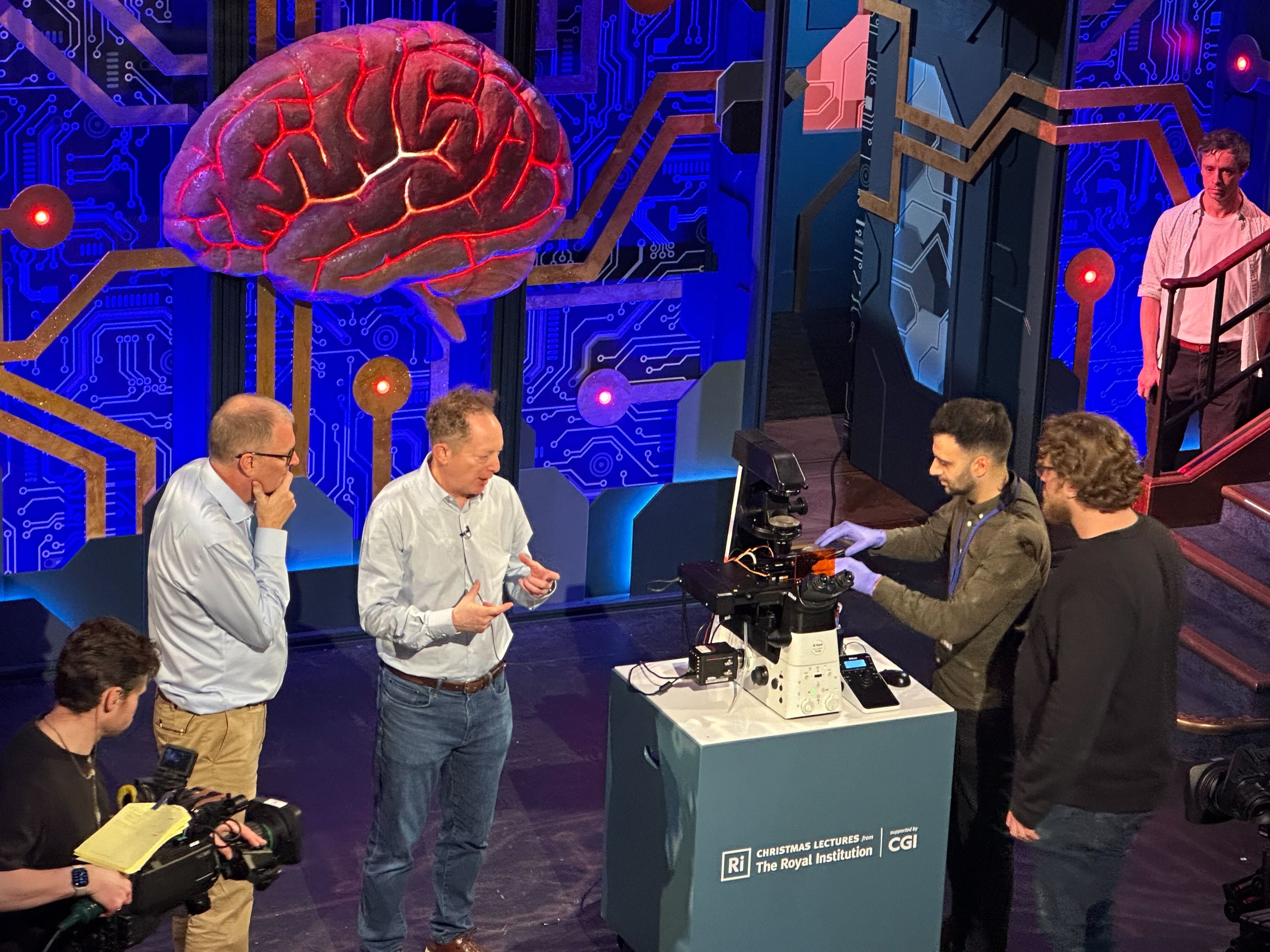27.12.2023 | Published by bit.bio

27.12.2023 | Published by bit.bio

The Christmas Lectures from the Royal Institution (Ri) is the oldest science television series as well as a British institution - initiated by Michael Faraday at the Ri in 1825 and first broadcast to a wider audience via television in 1936, the series established an exciting and engaging new way to present scientific advances and ideas to young people.
The lecturers over the years have included world famous scientists including Nobel Prize winners William and Lawrence Bragg as well as Sir David Attenborough, Carl Sagan and Dame Nancy Rothwell. And this year, the Lectures include a starring role for one of bit.bio's ioCells™️ products - ioGlutamatergic Neurons™️.
The 2023 Christmas Lectures, titled "The truth about AI", are delivered by Professor Mike Wooldridge who is tackling the big questions and unravelling the myths of AI research. bit.bio's cells appear in the first of the three lectures and are used to show neurons firing in a neural network, demonstrating how machine learning models are based on the natural workings of the human brain. In their first conversations with bit.bio, the RI said they had approached us as our cells were known for their consistency and ease of use. Whilst ioCells are normally used in laboratory conditions for research or drug discovery, we were up for the challenge of showcasing them during a live television broadcast.
To see the cells in the lecture, you can now watch the show - which was broadcast on the 26th December on BBC4 - on the BBC iPlayer. Below, you can discover the story of how the neurons were cultured, kept alive and delivered onto the stage for their moment in the spotlight.
Watch the timelapse to see the cells make their journey in a warm box from KCL to backstage before their moment on camera.
The key to ensuring the neurons arrived on the stage alive and firing was collaboration on multiple fronts.
The Christmas Lectures are filmed at the Ri's lecture theatre in London which is more than an hour away from bit.bio's headquarters at Babraham in Cambridge. However the labs of Professor Deepak Srivastava, our collaborator at the Institute of Psychiatry, Psychology & Neuroscience (IoPPN), King’s College London are just across the River Thames in London. The first problem was solved - Deepak and his team were more than happy to help by culturing the ioGlutamatergic Neurons in their labs ready to be delivered the day before filming. bit.bio shipped the product well ahead of time to Deepak and his team so they could culture the cells to maturity over 12 days.
The second challenge was how to keep the cells alive once they arrived at the Ri. An incubator would be needed and access to a space to feed and then prepare the cells for imaging. The team at the Ri worked to locate an incubator in the building and members of the bit.bio phenotyping team advised on the right set of conditions for the cells - temperature and CO2 flow. In the video above you can see the journey the cells took from the lab at King's where they were cultured all the way to the incubator that was set up at the Ri.
The final challenge was how to showcase the cells on the big screen during the lecture. A microscope that was easy to wheel onto stage had to be found. Again, the bit.bio phenotyping team set to work. They talked to various suppliers and thought through what technology would provide the best visual to excite the audience and landed with Nikon. Two engineers from the Nikon team were deployed to the basement of the Ri and built a microscope for the demonstration.
 Rehearsals ahead of the live broadcast - L-R: Professor Mike Wooldridge, Christmas Lecturer 2023, Daniel Glassier, Ri director of science engagement, Fuad Mosis, bit.bio phenotyping scientist and George Chennell, Wohl Cellular Imaging Centre (WCIC) Manager.
Rehearsals ahead of the live broadcast - L-R: Professor Mike Wooldridge, Christmas Lecturer 2023, Daniel Glassier, Ri director of science engagement, Fuad Mosis, bit.bio phenotyping scientist and George Chennell, Wohl Cellular Imaging Centre (WCIC) Manager.
Collaboration was once again key as an expert in the specific Nikon microscope from the Wohl Cellular Imaging Centre - which houses a Nikon centre of excellence - also located at the King’s site in London, joined the team to ensure the perfect image was captured and displayed quickly during the broadcast. For a look at how the neurons appeared, you can view the video below.
ioGlutamatergic Neurons in culture and firing, 10x speed.
From an introductory email to a collaboration between four different organisations and many keen individuals, this was one of the most exciting uses bit.bio has seen of its products. The fact that the cells survived a London taxi journey, moving from one incubator to another and the hot lights of live television is testament to the team and the power of cell programming.
The three Christmas Lectures from the Royal Institution will be broadcast on BBC Four and iPlayer, on 26, 27 and 28 December, at 8pm.